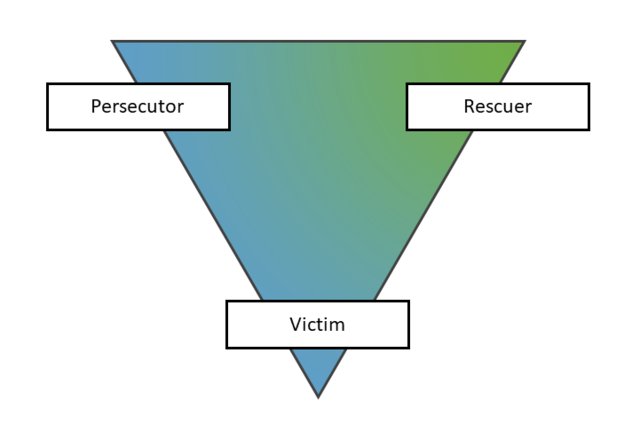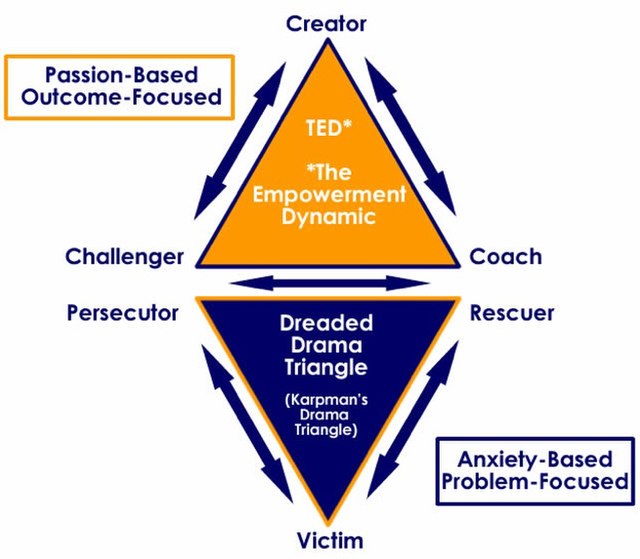What are drama triangles and how can understanding them improve your life?
“One moment you’re the hammer, the next the nail.”
Marty Rubin, on bullies and victims
A Karpman Triangle, better known as a Drama Triangle, is a common and powerful pattern.
And it induces misery for everyone involved. Understanding drama triangles can improve your health, relationships, and life.
First described by psychologist Stephen Karpman in 1968, a drama triangle is a relationship model consisting of three roles:
- The victim
- The rescuer
- The perpetrator
Together, the three participants form a highly destructive co-dependent relationship.

Starting in childhood, many people are wired to play one of these roles more than the other. It’s like a choreographed dance move they’re not conscious of doing and don’t even remember learning.
Only when these patterns are understood and recognized can they be disrupted.
The Victim
Mindsets: They perceive themselves to be a victim of someone or something. They feel small and weak, like a child.
An important caveat is that the sense of victimhood is based on perception. There are, of course, horrible situations where someone is truly being victimized. This model refers primarily to people who see themselves as the victim.
Motives: Avoid change and avoid acknowledging difficult emotions. Victimhood justifies staying stuck
Says things like:
“I’ve done everything I can. There’s just nothing that can be done.”
“If only I had X, I could get/do Y.”
“Life is happening to me.”
The Rescuer, aka “The Hero”
Mindsets: The victim is not capable of helping themselves, and they are depending on the rescuer to save them.
Motives: To be the hero (a huge ego boost). Focusing on other people’s problems also allows them to avoid working on their own issues. Lastly, they want to avoid guilt.
Says things like
*Heavy sigh* “I better go help.”
“Looks like she needs me and lord knows she’ll never figure it out on her own.”
“I’ll buy them a filet-o-fish sandwich from Mcdonald’s, but I won’t teach them how to fish.”
The perpetrator aka “The Villain”
Mindsets: The situation is someone else’s fault, usually the victims’. No matter what, they do not bear any responsibility for the circumstances
Motives: To have power and control in the situation, and to avoid feeling guilty.
Says things like:
“He just can’t get out of his own way.”
“It’s not my fault that she’s an idiot.”
“You provoked me.”
Why do people stay trapped in Drama Triangles?
From the outside, Drama Triangles can look nonsensical. “Why,” we wonder, “would he stay in that awful relationship?” Or, “She hates that job and they treat her terribly. Why doesn’t she quit?”
But there is a method to the madness.
Drama triangles often feel normal for the participants. They may tend toward playing certain roles. Often this stems from the family dynamics they experienced as children.
And, at some level, they are getting important social and emotional needs met.
As a result, people can stay trapped in them for a very long time.
Where are Drama Triangles showing up in your life?
Drama Triangles aren’t just between individuals. They can also be used to describe the dynamics of organizations.
Often, they are created (unwittingly) by leaders. For example, there might be a boss in the perpetrator role, team members who play the role of the victim, and the boss and/or members of the team stepping in to play the role of the rescuer.
Mindblowingly, you can even be in a drama triangle with… yourself!
Imagine you’ve been overworking yourself. You can “rescue” yourself by mindlessly overeating instead of going to the gym. You then “persecute” yourself: “Wow, I just ate that entire pint of ice cream. I am gross.” And the whole time you’re playing the victim, powerless in the face of your job and your exhaustion.
The fascinating thing about drama triangles is that everyone is in fact competing to be the biggest victim. It’s a whole big Victim Olympics!
The victim is just the most transparent about it.
The rescuer believes they are being victimized by their heroic obligations.
The perpetrator believes they are being victimized by the “original” victim’s behavior.
No one wants to take responsibility for their behavior, and so on and on it goes.
Transcending a drama triangle
The good news is there is a way out of this nasty, no-good, particularly rotten pattern.
It’s called the Empowerment Dynamic (aka TED). Coined by David Emerald Womeldorff, TED describes an alternative pattern that is infinitely more constructive for everyone involved.
You can think of it as an anti-drama triangle.
In the TED model, each person becomes a healthier, more generative version of themselves.

The Victim becomes The Creator
- The creator is self-confident, applies problem-solving skills, and takes responsibility for themselves.
The Rescuer becomes The Coach
- The coach teaches, encourages, and motivates. Unlike the rescuer, who depends on their role for self-esteem, they are non-attached to the outcome. They are a supportive partner to the creator’s growth.
The Perpetrator becomes The Challenger
- The challenger offers the creator honesty and perspective in a safe, caring way that inspires growth and learning. There is no blame or judgment.
This transformation starts when the participants become aware of the dynamics of the drama triangle and assume responsibility for their role in perpetuating it. They can then begin to act from a place of empowerment. Therapy can be a great place to do this, and I wrote about getting started with it here.
When we transcend drama triangles we can create healthier relationships in almost every area of our lives.


One thought on “What are drama triangles and how can understanding them improve your life?”
Comments are closed.